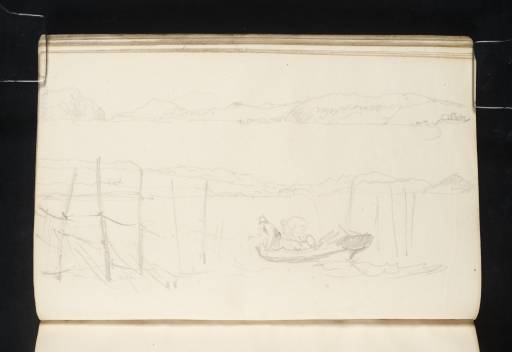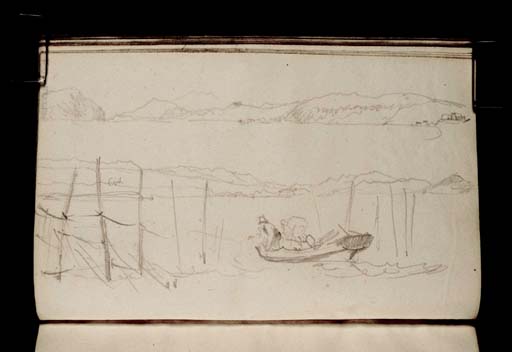J.M.W. Turner
>
1830-35 Annual tourist
>
Scotland 1831
>
Inverness Sketchbook
>
Artwork
Joseph Mallord William Turner Stake-Net Fishing at ?Cromarty 1831
Image 1 of 2
Joseph Mallord William Turner,
Stake-Net Fishing at ?Cromarty
1831
Joseph Mallord William Turner 1775–1851
Folio 28 Verso:
Stake-Net Fishing at ?Cromarty 1831
D27086
Turner Bequest CCLXXVII 28a
Turner Bequest CCLXXVII 28a
Pencil on off-white wove paper, 104 x 163 mm
Accepted by the nation as part of the Turner Bequest 1856
References
1909
A.J. Finberg, A Complete Inventory of the Drawings of the Turner Bequest, London 1909, vol.II, p.883, CCLXXVII 28a, as ‘Loch, with mountains; fishing nets in foreground.’.
The larger sketch on this page depicts stake-net fishing, a technique where nets are suspended between stakes to form a wall across a river. The two figures in the boat are either laying or hauling in the net, presumably to catch salmon, which is common in the Cromarty Firth where this sketch may have been made. David Wallace-Hadrill has suggested that the two sketches on this page were made around Cromarty at the mouth of the Cromarty Firth. Therefore the left-hand side of the sketch at the top of the page may depict the North and South Sutors of Cromarty – headlands at either side of the river mouth.1 The fishing scene would therefore be taking place in Cromarty harbour, with the northern shore of the firth in the distance.
The harbour at Cromarty was, according to Hugh Munro (who probably accompanied Turner on his excursion around the area), the model for the harbour in his painting Mercury and Argus 1836–40 (National Gallery of Canada, Ottawa):2 ‘Cromarty, I believe, is only famed as a good harbour. Turner thought by enlarging, something might be made of it; and this idea he realized in his Mercury and Argus’.3 Finberg suggested that ‘one of the objects of [Turner’s] revisions in the painting may have been to disguise this resemblance and give the landscape a more classical or Claudesque character.’4 However, as Butlin and Joll point out, Turner made a design for the subject around 1804 in the Studies for Pictures: Isleworth sketchbook (Tate D05575; Turner Bequest XC 54), and the landscape in the final design ‘is now so entirely Mediterranean and Southern in feeling that it is hard to detect the slightest trace of the Scottish topography which Munro claimed as the model for the picture.’5 Michael Kitson has also pointed out the debt that Turner’s painting owed to Claude’s Landscape with Rest on the Flight to Egypt.6 Whether or not Cromarty Harbour did, either topographically or imaginatively, serve as the inspiration for Mercury and Argus there is certainly no resemblance in the painting to the current sketch.
There may be another sketch of Cromarty Firth on folio 64 (D27128). Turner is likely to have crossed the firth after visiting Hugh Munro at Novar House near Evanton. From Cromarty he could have travelled south to Rosemarkie and Fortrose before crossing the Moray Firth to Ardersier or Inverness.
Thomas Ardill
April 2010
David Wallace-Hadrill and Janet Carolan, ‘Sketchbook CCLXXVII Inverness’, [circa 1991], Tate catalogue files, [unpaginated].
Martin Butlin and Evelyn Joll, The Paintings of J.M.W. Turner, revised ed., New Haven and London 1984, pp.217–19. no.367.
Alexander J. Finberg, The Life of J.M.W. Turner, R.A. Second Edition, Revised, with a Supplement, by Hilda F. Finberg, revised ed., Oxford 1961, p.382.
How to cite
Thomas Ardill, ‘Stake-Net Fishing at ?Cromarty 1831 by Joseph Mallord William Turner’, catalogue entry, April 2010, in David Blayney Brown (ed.), J.M.W. Turner: Sketchbooks, Drawings and Watercolours, Tate Research Publication, December 2012, https://www


